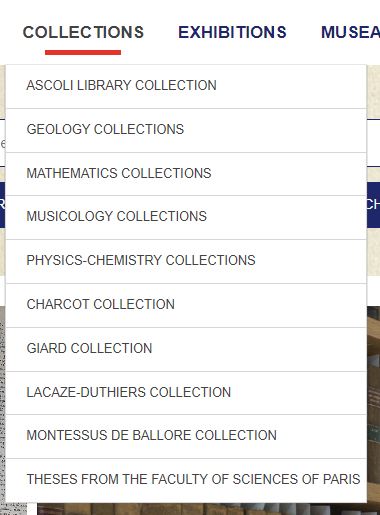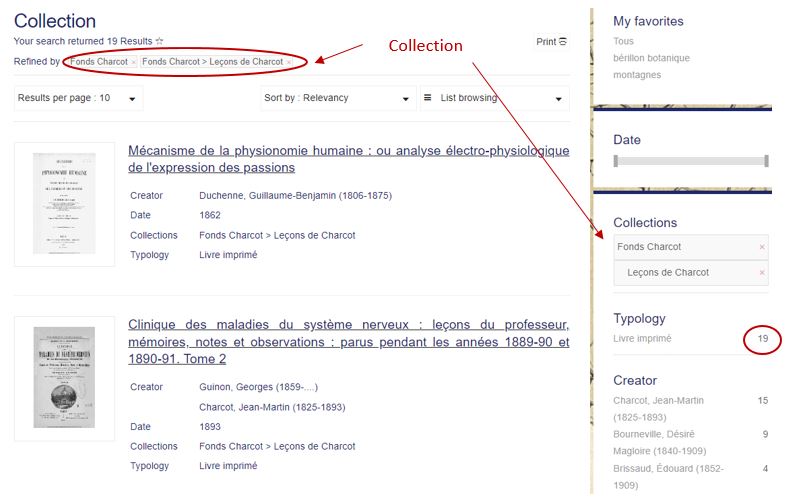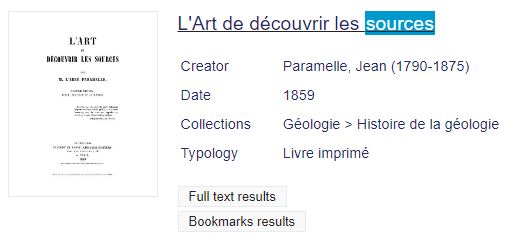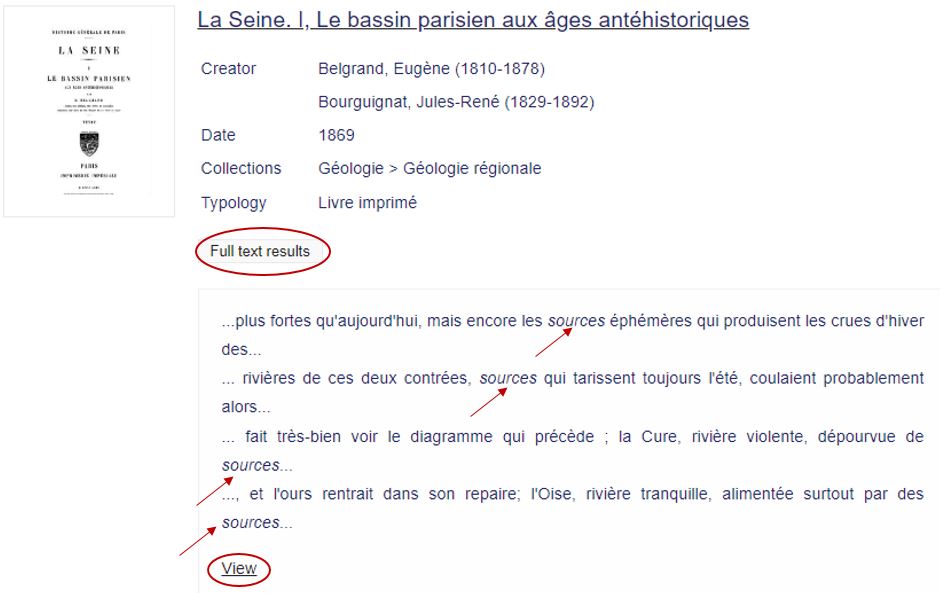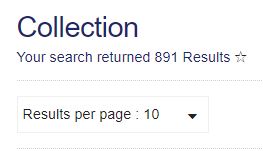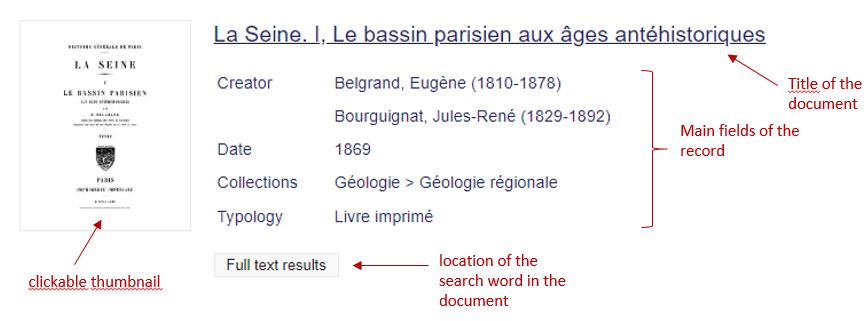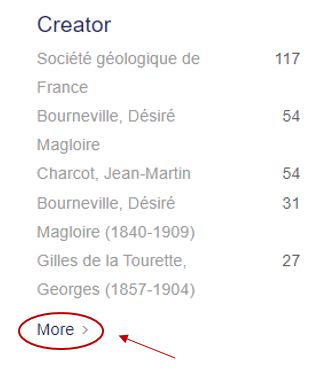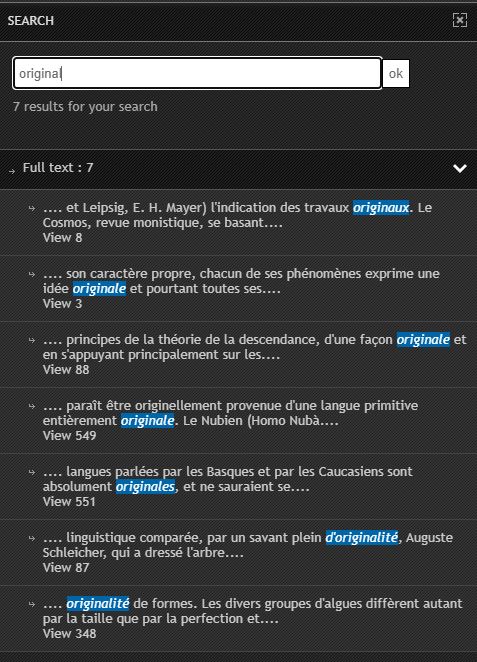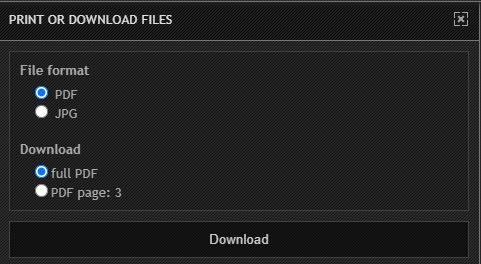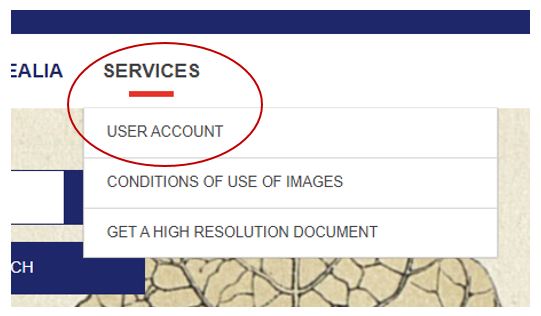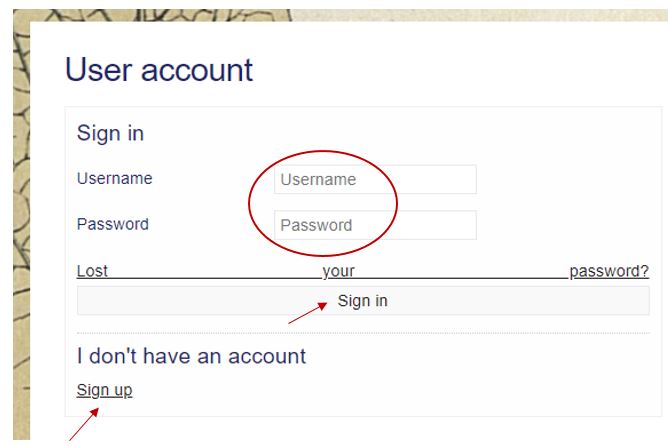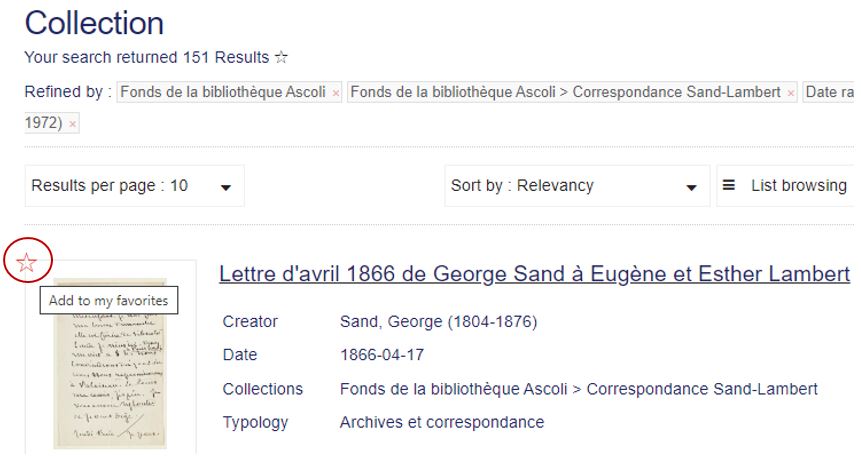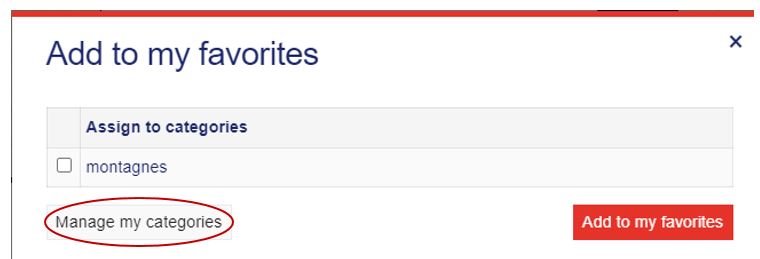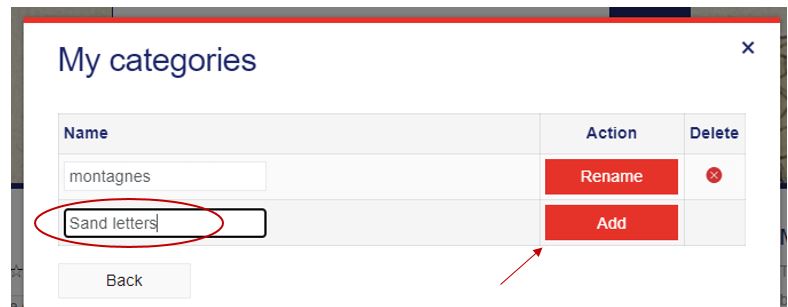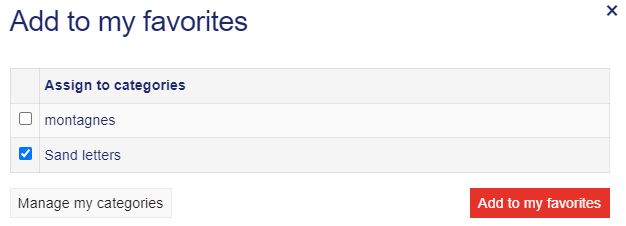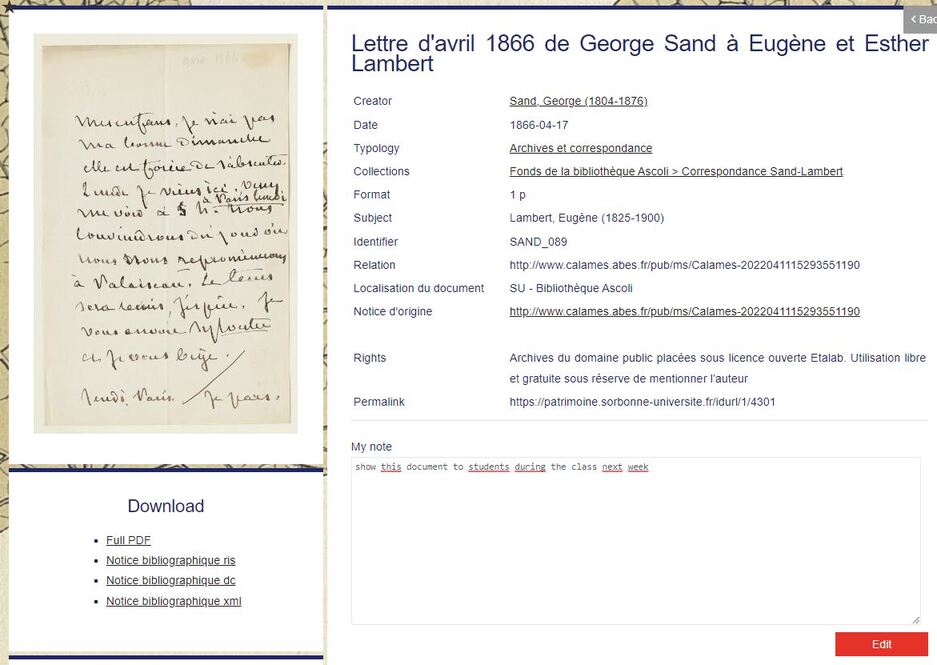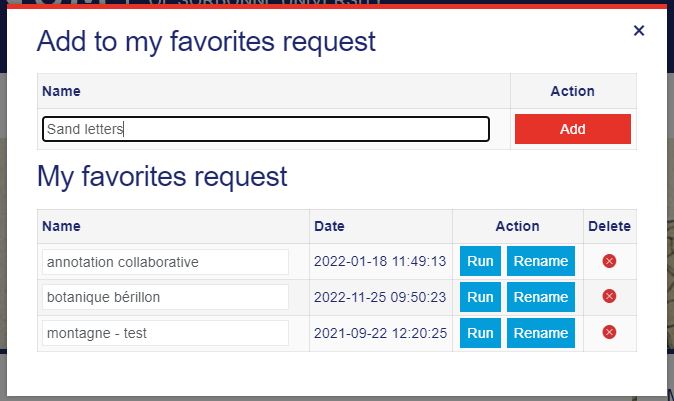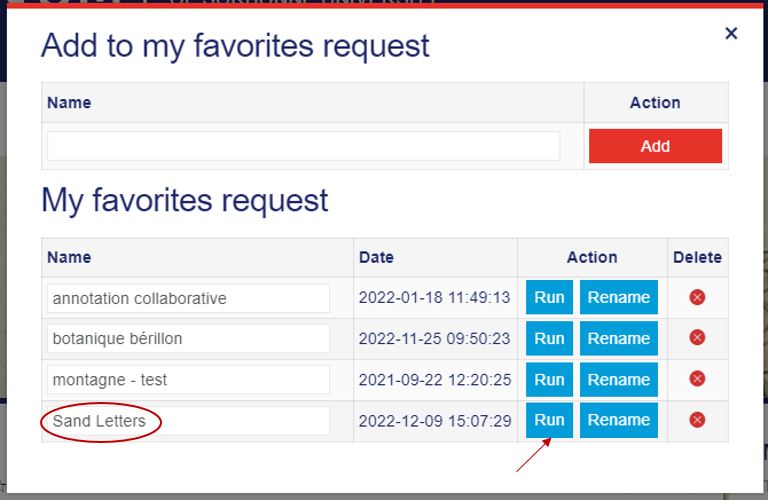Research assistance
Here are some tips for browsing the collections and performing a search.
Contents
Browsing the collections
There are several ways of accessing the SorbonNum collections.
The editorial pages
These pages present the different holdings and collections of the digital library.
The Collections menu is located in the bar at the top of the website:
The drop-down menu of all collections in the digital library is displayed when the mouse is moved over the Collections button:
Each page is built according to the same model:
- Re-contextualisation of the digitised collection: provenance and history of the collection,
- Introduction to the collection: its particularities, importance and originality,
- The typology of the documents making up the collection,
- A few focuses on specific documents.
At the end of each page, a clickable "Access the Collection" button links to a list of all the documents in the collection :
Browsing by the collections
This button displays a page that shows the entire network of collections and sub-collections.
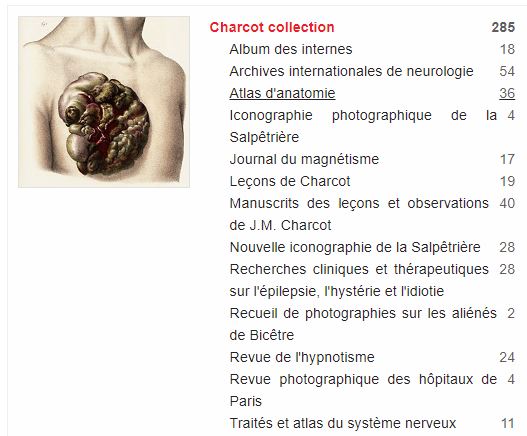
The main collections and holdings are shown in red. The sub-collections and sub-holdings are listed below, in alphabetical order, with the number of corresponding documents. All entries are clickable and display all the documents listed in them.
For example, for Charcot's lessons, we can see that this sub-collection consists of 19 documents. Clicking on the sub-collection will reveal a search results page with the 19 documents:
The carousel
Another way of browsing the SorbonNum collections is according to document typology.
The carousel contains 9 types of documents contained in SorbonNum: printed books, periodicals, archives and correspondence, iconography, scientific collections, manuscripts, musical scores, maps and audiovisual collections.
Clicking on a thumbnail takes you to the search results page, displaying all the documents corresponding to this typology, for all collections combined.
Printed Books will therefore reveal works from the Charcot collection, geology, physics and chemistry and all theses, and so on.
The carousel has automatic scrolling.
Performing a simple search
By default, the simple search will scan the entire text. This means that a search term will be searched for not only in the document title but also in the fields of the record (author, publisher etc) and in the full text.
If the search contains more than one term, for example "marine world", it is advisable to use the advanced search.
The search bar will offer suggestions that can guide the search for the appropriate term
For example, by searching for the term "source". The search returns 891 results. The first 7 have the term in the title, and the term is underlined:
In contrast, the last records on the first page of the search do not include the term in the title. The term is however found in the body of the document. Clicking on "full-text" search results will reveal all instances of the term in the publication:
Clicking on the "View" button opens the viewer at the point where the term is first used.
Performing an advanced search
The advanced search is ideal:
- When the search has more than one search term that you want to be considered as a whole phrase; for example "marine world" or "space geology". In this case, it is advisable to use inverted commas, otherwise the search engine will split the expression and search each word independently.
- When the search is carried out in a dedicated area of the record (title, name of journal etc). Similarly, it is advisable to use inverted commas for expressions.
Search fields can be combined, and traditional Boolean operators can be used.
Understanding the results
By default, results are displayed 10 at a time and sorted according to relevance. The notices are brief. The number of results is shown at the top of the results page.
It is possible:
- to display a larger number of results per page (20 or 50). In this case, however, the loading time will be longer.
- sort according to title (ascending or descending order), publication date or order (particularly useful for series and periodicals).
- and finally, to display the records in a different way, as a mosaic or table of records.
A record includes:
- a thumbnail image of the document. It is clickable and opens the full record.
- the title of the document. It is clickable and opens the full record.
- a number of fields in the record: author, collection, type of document.
- an optional insert indicating the location of the instance searched for.
Filtrering the results
In the right-hand column of the results page, facets are used to filter the results.
These facets correspond to fields within the records. Different facets:
- Collection, which corresponds to the principal collections and holdings within the digital library;
- Type of document, which corresponds to the typology of the carousel;
- Name of the publication,
- Author,
- Publisher,
- and subject.
By default, each facet displays only five entries, except for the “Collections” facet, which displays them all. A "plus" button opens a pop-up window with the full range of entries for each facet.
The number of documents is indicated for each entry.
As filters are applied, the search will automatically restart. The filters applied can be seen above the results. They can be deleted at any time by clicking on the cross in each filter:
The record
The title of a record in the search results is clickable, like the thumbnail, and opens the complete record.
The return button at the top right of the full record will take you back to the search results.
The fields whithin the record
It includes a series of facets, which are clickable and allow a more in-depth search. This is the case for the name of the journal, the author, the publisher, the collection and the type of document.
The record also includes the original call number, the location of the document and a link to the record of the document located in the SUDOC. Finally, it contains a permalink, a permanent URL for the digital document.
The thrumbnail
The thumbnail is clickable and corresponds to the first page of the document. It opens the viewer to access the content.
Downloads
As the documents are covered by an Etalab licence, they are freely reusable. A digital copy can therefore be obtained in PDF format with integrated OCR for printouts, directly within the record.
The records can also be downloaded in different formats.
Please note:
The documents are distributed as low resolution JPEG files for storage/navigation reasons. A high-definition image file can therefore be obtained by clicking on the "obtain high-definition file" button. This is a free service.
There is a form to fill in with an e-mail address (to which the files will be sent), the desired format, and the precise reference (plate, page etc).
Image downloads are available directly in the viewer.
Sharing the record
Finally, the record can be shared on social networks (Twitter, Facebook) and by email, and is available in a printable version.

The viewer
The top bar of the viewer shows the title of the book being read. The arrows in the top right corner scan the search results. Clicking on < or > will open the previous or next document within the results. The cross will close the viewer and return you to the full document record page.

The lower bar contains the image-processing tools (rotation, zoom, different display modes etc) and allows various items of information on the document (OCR, table of contents and notice) to be obtained:

The bottom right shows the page currently viewed out of the total number of pages. By this means, the pages can be browsed through, or the desired page directly indicated:

Finally, there are middle arrows on the right and left for scrolling through the pages.
Navigating the document
By default, the document is displayed in one view = one page.
Note: all image-processing options (rotation, zoom, contrast, negative etc) and OCR are available only in this simple mode.
However, double-page spreads can be displayed using the buttons in the bottom left-hand bar:

The page-turning mode most closely resembles a book, with the pages turning.
Facing pages are displayed in pairs, but are separate and constitute two distinct views. In this case, the document can be browsed through by using the mouse wheel to scroll down.
Record display and OCR
The record can be displayed next to the document by clicking on this button:

The main fields of the record are found on the left-hand side of the document.
To display the OCR, click on this button:

Then drag the mouse over the image. The text is highlighted in the image, and the transcription appears on the left:
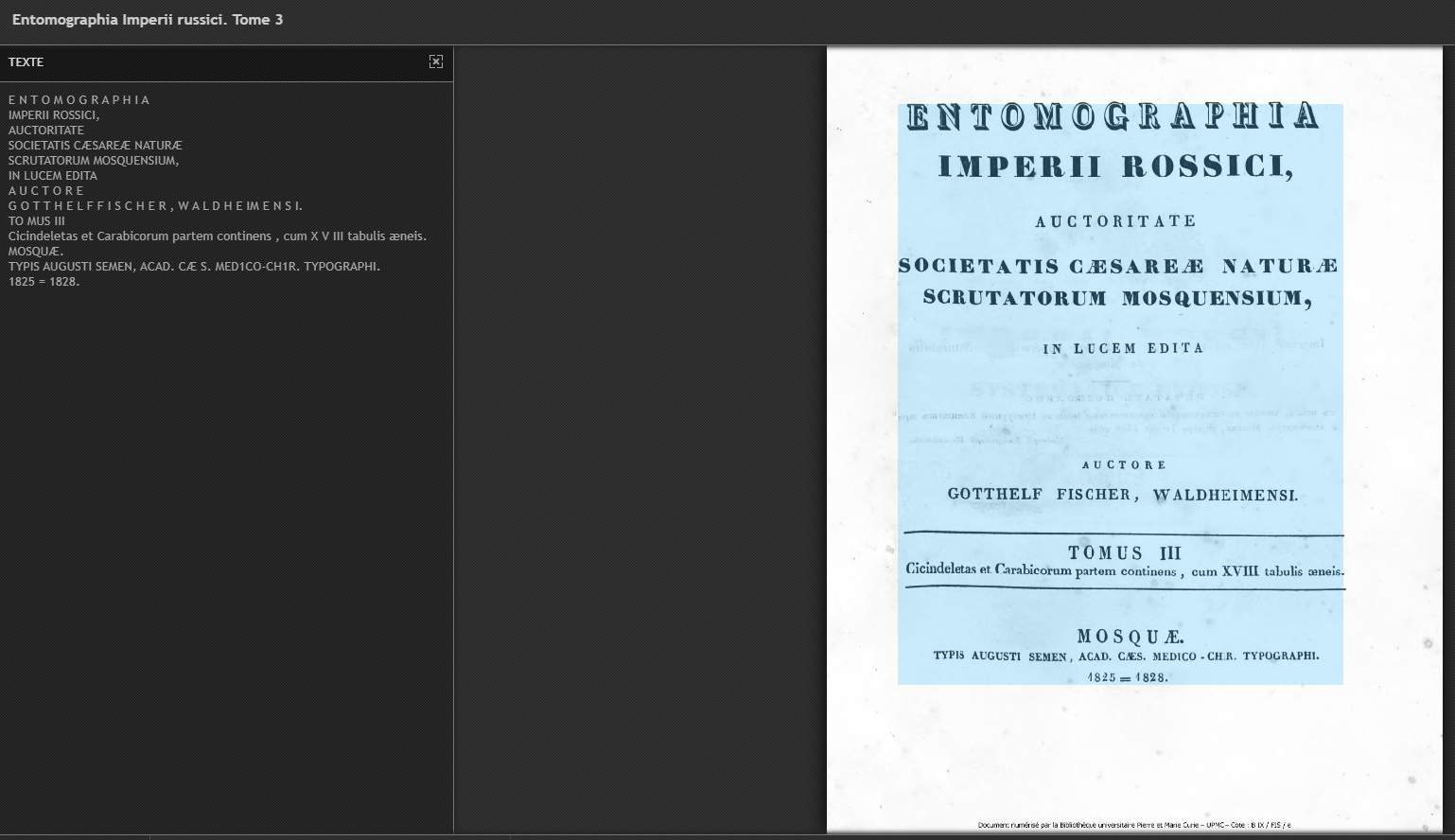
To perform a full-text search, click on the magnifying glass symbol:

Enter the word or phrase in the search bar that appears, and click OK.
The results will appear listed beneath, with the word highlighted:
Each result is clickable, and displays the page on which the word was found.
By clicking on the first result, the viewer will open the corresponding page:

The instance is highlighted in the image.
Displaying the contents table
Some documents have a navigable contents table. In the viewer, this little button appears in the bottom menu bar when a table of contents is available:

This displays the contents table in the left pane of the viewer, and each entry is clickable, linking directly to the document.
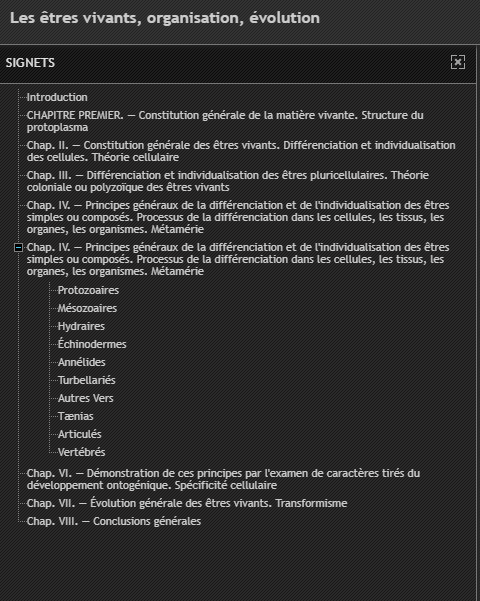
Image processing
The + and - buttons on the bottom bar allow you to zoom in and out (this can also be done with the mouse wheel).
It is also possible to rotate the document, open an additional overview (especially when zooming in on the image), change the contrast, and obtain the image in negative form.
Downloading an image
To obtain a PDF (full or of the current page) or an image (portion or current page), click on the button:
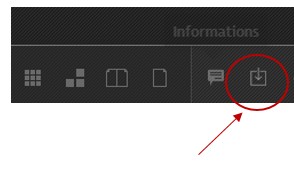
Then fill in the necessary information and click on Download:
The user account
Create an user account ang log in
Additional services are available in the reader account. To create a reader account, click on the "Services" tab in the top bar and then on "User account":
If an account has already been created, click on "Register" and fill in the fields indicated. If the account already exists, the fields will be pre-filled. Click on "Log in":
Ceating favourites
SorbonNum allows you to create baskets of records that can be saved as favourites for easy retrieval. These records can be classified into categories.
For example, the search for “botany" with the author filter "Bérillon, Edgar" returns 7 results.
At the top left of each thumbnail that accompanies the record, a small star can be clicked to save the record :
If lists of favourites have already been created, these will appear in the pop-up list. Click on the desired category and then on "Add to favourites".
To create a new category of favourites and save the record in that category, click on "Manage categories" :
Enter the name of the new list to be created and click on "Add":
Then click on "add to favourites" to drag the record into the newly created category:
Lists of favourites can be found on the results page at the top right:
Annoting a saved record
As soon as a record is saved, it can also be annotated. Click on the title of the short record saved. The long record will open.
An insert below the fields in the record allows notes to be added :
Once the text has been entered, click on "Edit": a pop-up window will open indicating that the note has been saved.
Saving a search
The last tool of the reader account is saving and and executing a request.
On the search results page, next to the number of results found, is a small star that can be clicked to save the request:
A pop-up window opens, and just as for the favourites baskets, the list of previously saved requests is displayed, with an insert to name the new query:
Click on "Add" to save the request.
The request can then be executed at any time. Requests can be found by clicking on the star next to the number of results for any search.
The request is dynamic and will adapt to the addition of new content: if a subsequent record of Edgar Bérillon concerning a work including the word “botany" is integrated in SorbonNum, it will appear in the query




